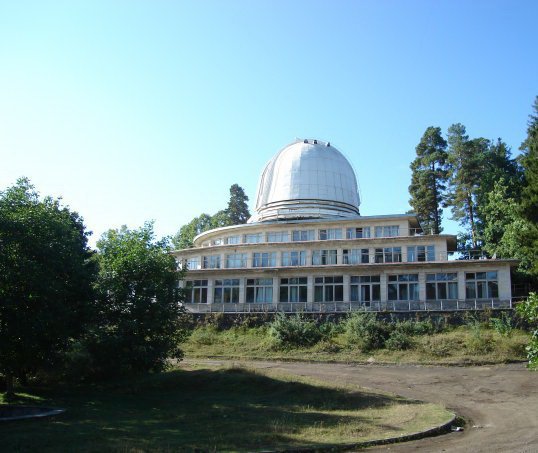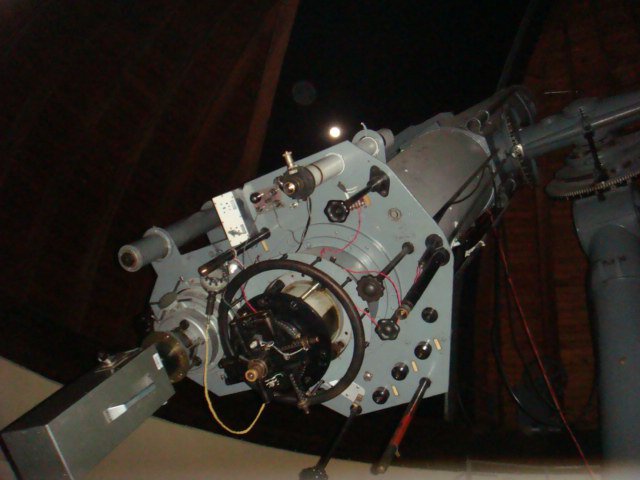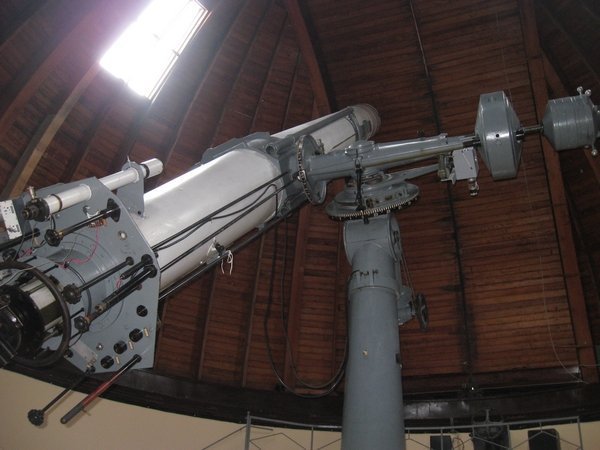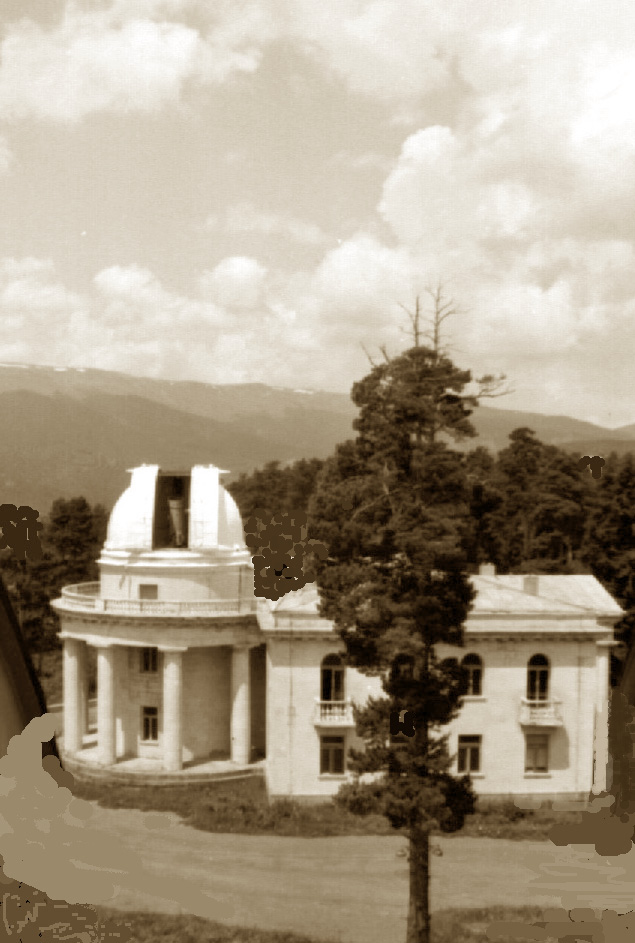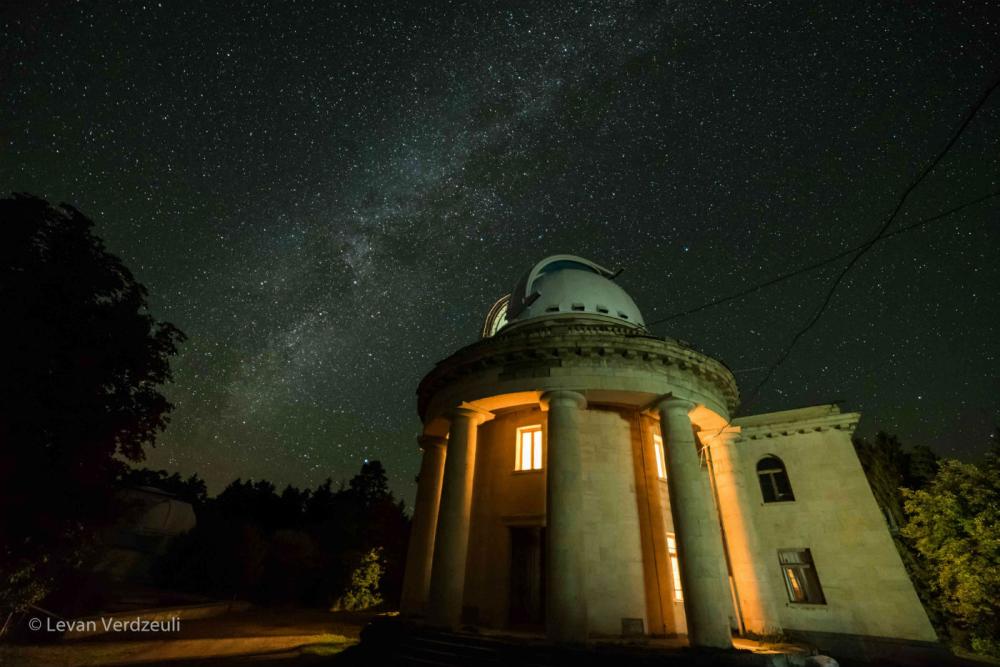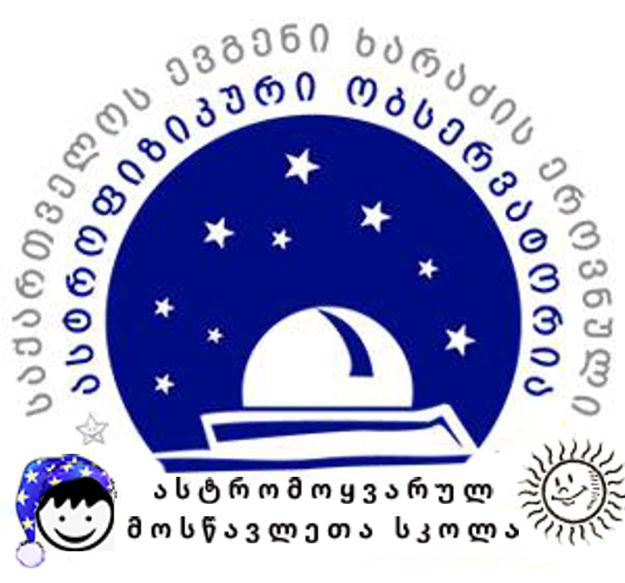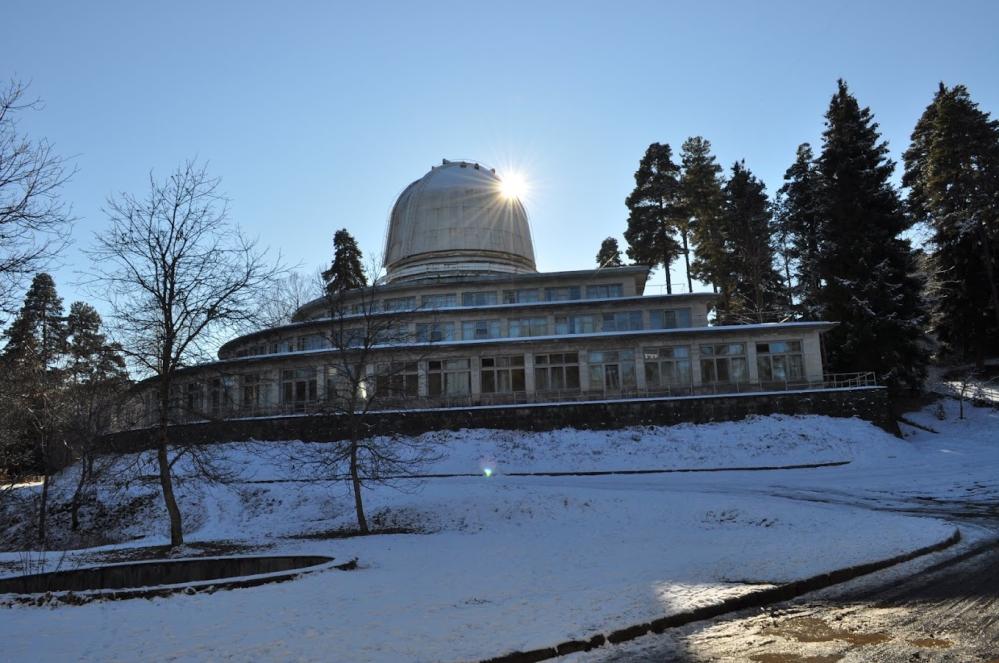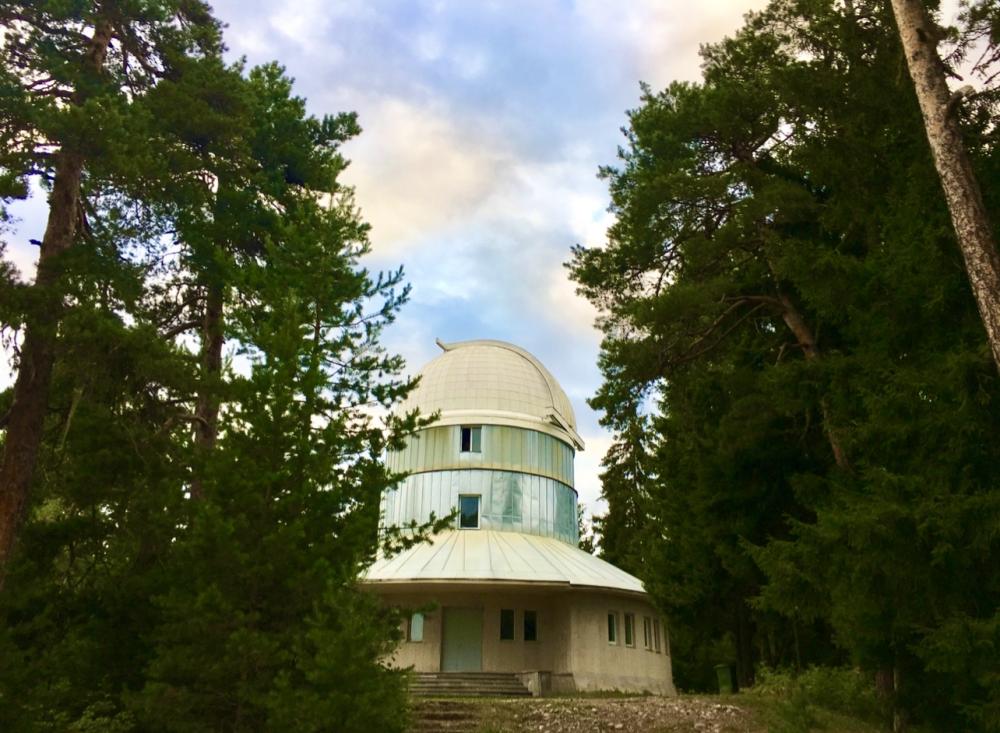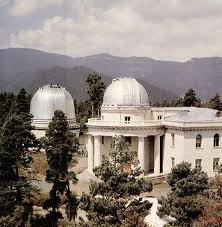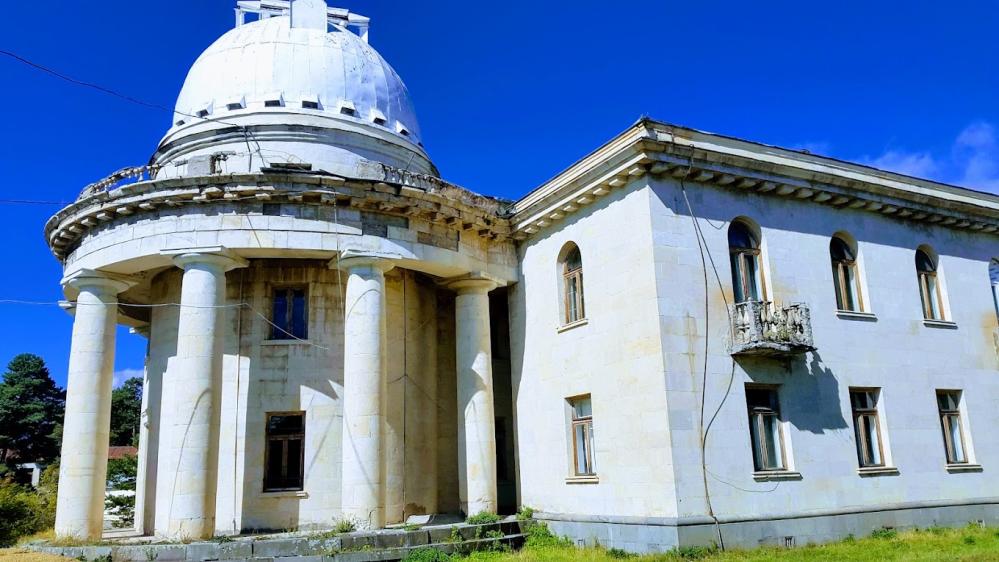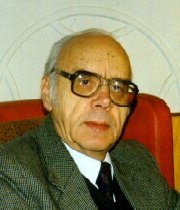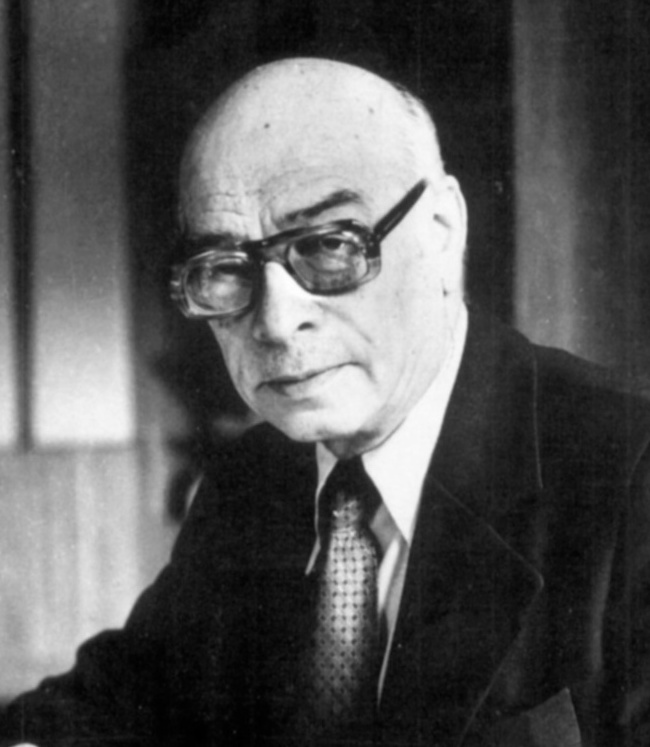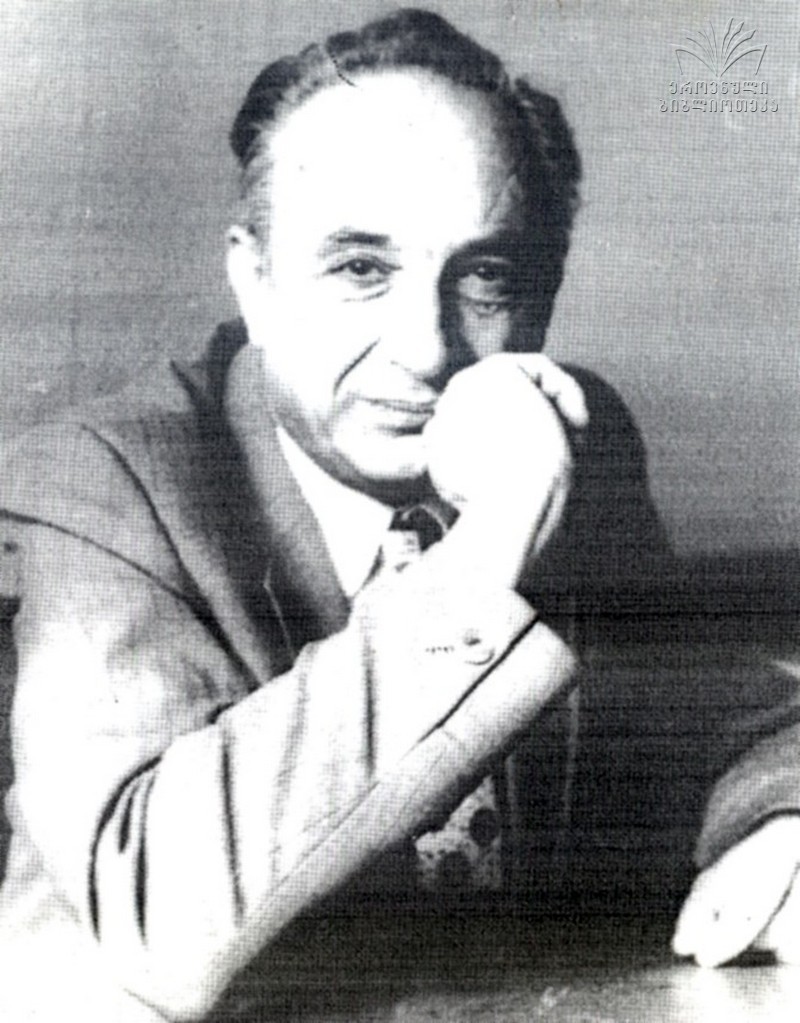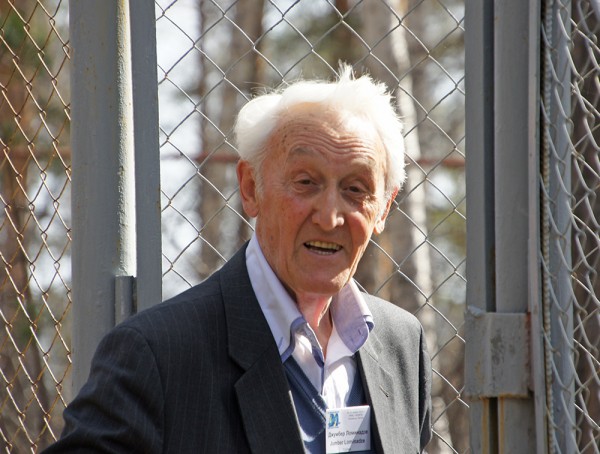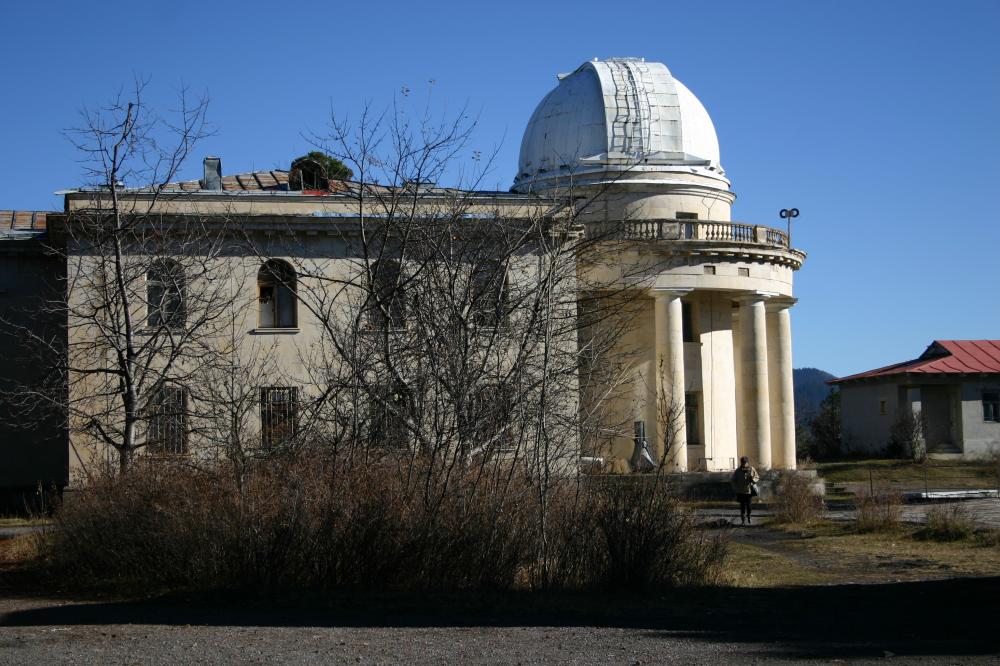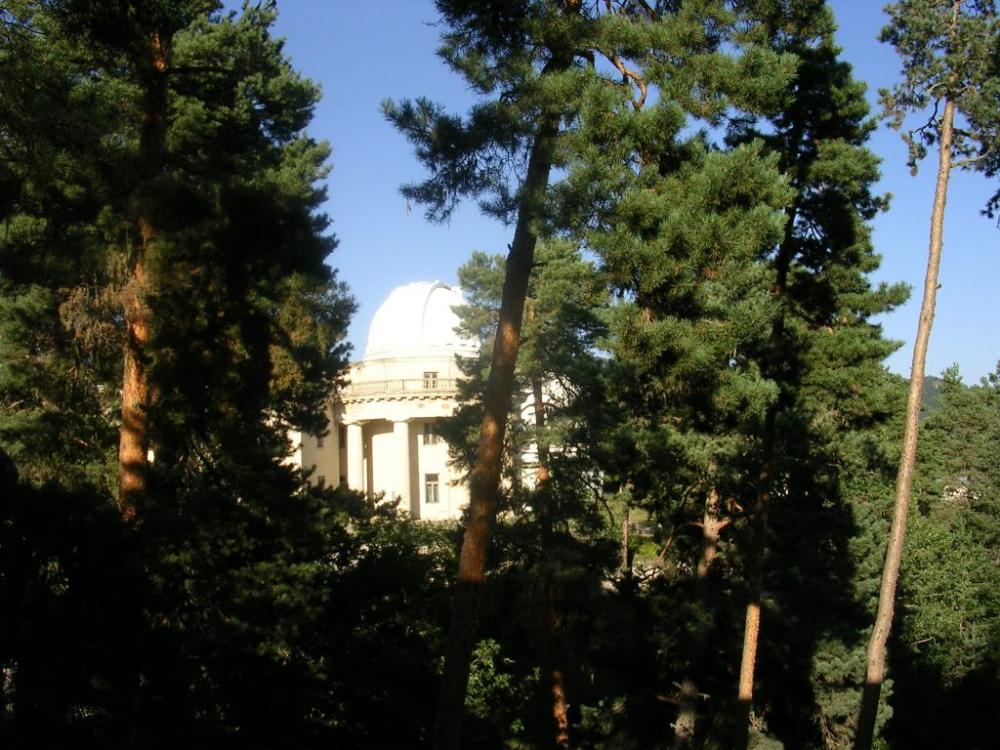
Category of Astronomical Heritage: tangible immovable
Abastumani Observatory, Georgia

Description
Geographical position
Abastumani Georgian National Astrophysical Observatory (GENAO), Georgia
See also: Georgian National Astrophysical Observatory -
City Department, Kazbegi ave. 2a, 0160, Tbilisi, Georgia
Location
Latitude 41°45’15’’ N, Longitude 42°49’10’’ E, Elevation 1650m above mean sea level.
IAU observatory code
119
Description of (scientific/cultural/natural) heritage
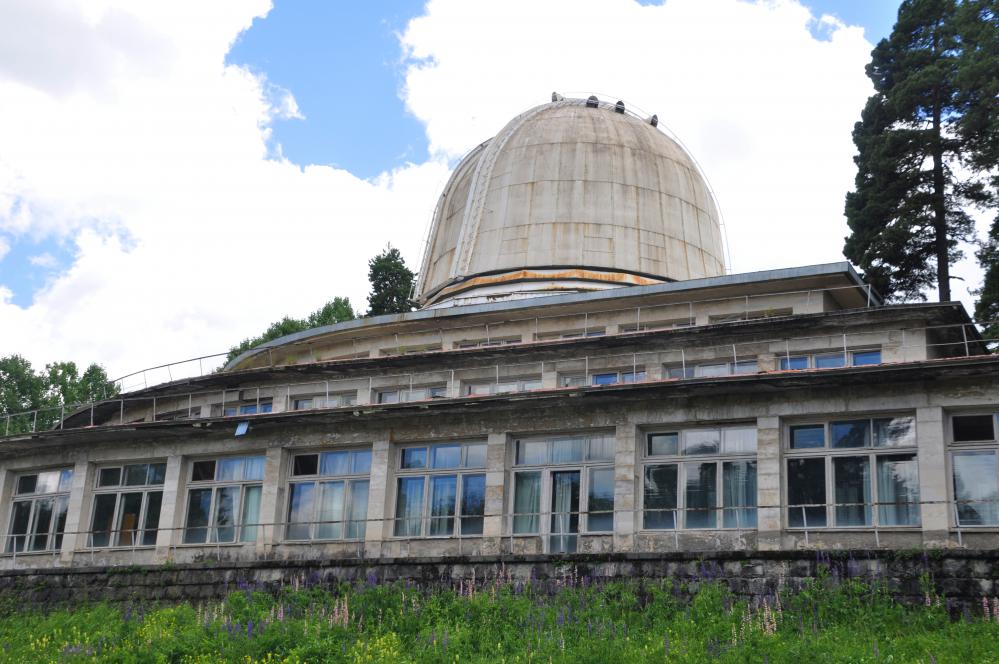
Fig. 1. Abastumani Astrophysical Observatory (*1932), Library, Lecture Hall, Dome of the 125cm-Ritchey-Chretien (Wikipedia 2, Sarah Murray)
Back in 1892, a first mountain temporary observatory was erected by the University of St. Petersburg. Sergey Pavlovich Glazenap (1848--1937) observed close binary systems using a 9-inch-refractor.
The Abastumani Astrophysical Observatory, founded in 1932 by the Academian Evgeni Kirillovich Kharadze, is an institution of the Georgian Academy of Sciences. An observatory bulletin was already published since 1937.
The Abastumani Observatory is located 250 km from Tbilisi, the capital of Georgia, -- far enough from air pollution and artificial illumination -- a perfect dark sky with excellent atmospheric conditions. The Observatory is on Mount Kanobili in the Caucasus at an altitude of 1650m near the town of Abastumani and was the first high mountain observatory in the Soviet Union.
Mikhail Vashakidze was among the first to discover polarised radiation in the Crab Nebula (Burton 2015).
After the Soviet regime, there were difficult times, which ended only after 2004's Rose Revolution, which brought in new, Western-leaning president Mikhail Saakashvili. In 2008, the Abastumani Observatory was attached to Ilia State University in Tbilisi. USAid programme helped to preserve part of the observatory and instruments in a museum.
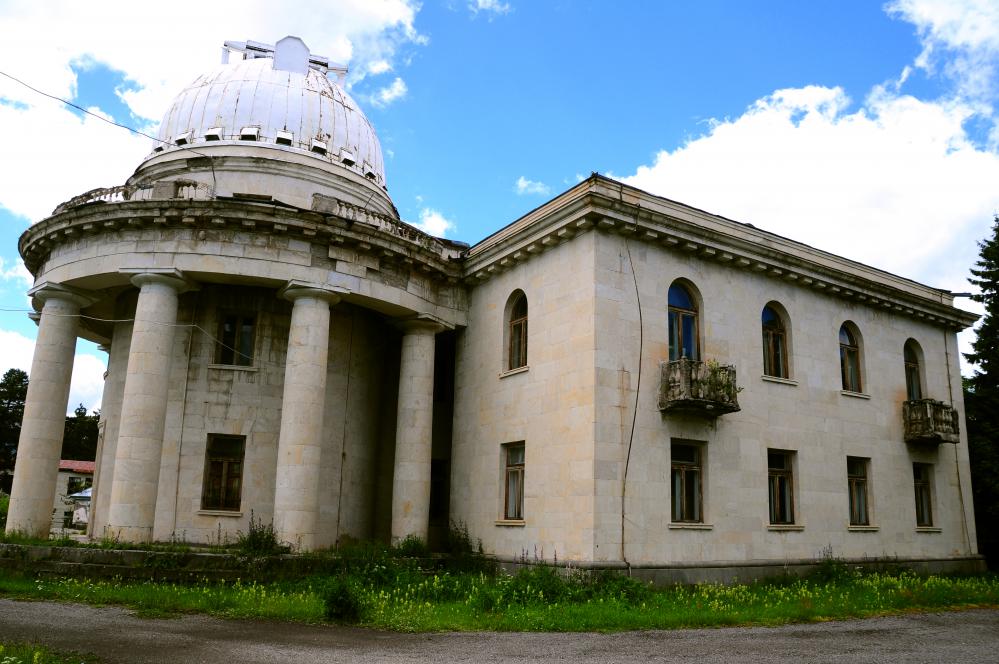
Fig. 2. Abastumani Astrophysical Observatory (*1932), Dome of the 70-cm-Maksutov (Wikipedia 2, Sarah Murray)
Observatory Directors
- 1932 to 1992 -- Evgeny Kirillovich Kharadze (1907--2001),
he headed the observatory for 60 years, and acted as an honorary director from 1992 to 2001, also Vice-president of International Astronomical Union (1976 to 1982).
In addition, he was rector of the Tbilisi State University (1959 to 1966), vice-president (1972 to 1980), and president (1980 to 1986) of the Georgian SSR Academy of Sciences.
Kharadze published the monograph Catalogue of the Color Indices of 14000 Stars and Investigation of Light Absorption in the Galaxy on the Basis of Color Indices of Stars (1952), and the handbooks The Course of General Astrophysics, Principles of Astronomy.
In addition, he discovered the dependence of the line shift in the light spectrum of P Cygni on the ionization potential of the respective chemical elements (1967).
In 1992, the Abastumani Astrophysical Observatory was renamed National Astrophysical Evgeny Kharadze Observatory Abastumani, and attached to Ilia State University in Tbilisi.
Kharadze was honored by naming the asteroid 1247, discovered by the Richard Martin West, after him (Schmadel, 2003). - 1992 to 2000 -- Jumber Georgievich Lominadze (1930--2014),
he was head of the Center for Plasma Astrophysics (2000 to 2006), created at the Observatory on his initiative. He also initiated the creation of the Georgian Space Agency, which he headed from 2003 to 2006, then in 2006, reorganized into the Space Research Center at the Georgian Institute of Geophysics. - 2001 to 2006 -- Rolan Ilyich Kiladze (1931-- 2010),
he studied the motion and origin of bodies in the Solar System, determined the mass of Pluto (1967). Using the photometric method, Rolan Kiladze calculated the thickness of the rings of the planet Saturn (1969), which was confirmed in 1995 by observations made using the Hubble Space Telescope. He discovered a supernova in the constellation Cygnus (1975). In addition, he developed a theory about the modern rotation of planets, which was confirmed in 2005 by the discovery of two more small satellites of Pluto (1986).
In honor of R.I. Kiladze, the minor planet 4737 Kiladze was named after him. The International Astronomical Union named one of the craters of the planet Pluto Kiladze Crater for his contributions to the study of photometry, astrometry and dynamics (2019). - 2006 to today -- Georgi (Gia) Javakhishvili
History
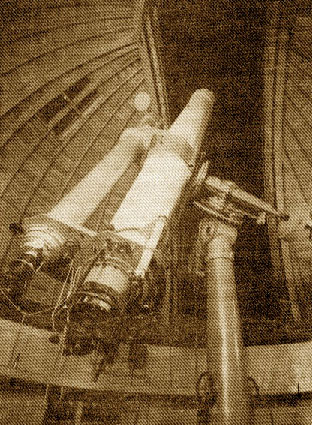
Fig. 3a. 40-cm-Zeiss-Refractor (© Abastumani Astrophysical Observatory)

Fig. 3b. Domes of the 36-cm-Zeiss-Schmidt Camera and 33-cm-Reflector (© Abastumani Astrophysical Observatory)
Original Instruments
"We have 14 telescopes, two of them work." (Dr. Maia Tordua, Abastumani Observatory's director), (Burton 2015): The Zeiss 40-cm-Refractor (1937), and especially, the 70-cm-Meniscus Telescope (1957).
- 33-cm-Reflector (1932), now in the Museum of GENAO
- Pendulum clock, Ericsson (1902)
- 40-cm-Refractor, Carl Zeiss of Jena (1936/37)
- 36cm / 44-cm-Schmidt Camera, Carl Zeiss of Jena (1940)

Fig. 4. 70-cm-Maksutov (© Abastumani Astrophysical Observatory)
- 70-cm-Meniscus Telescope (1955/57) (main mirror 975mm), designed by Kharadze.
The 70-cm-meniscus is made of a transparent UV crown glass for a near ultraviolet, 1:3, focal length 210cm), photographic plates 18x18cm, 4°x4° field of view. A 725-mm-lens is placed in front of the meniscus at an angle of rotation of 8°. With an objective lens prism, star spectra with a dispersion of 160 Å/mm are obtained. - 48-cm-Cassegrain Reflector (1968)
Modern Instruments since the 1970s
- 40-cm-Double Astrograph, Carl Zeiss of Jena (1978)
- 125-cm-Ritchey-Chrétien Reflector (1977)
- Scanning-mirror photometer
- Spectrograph SP-48
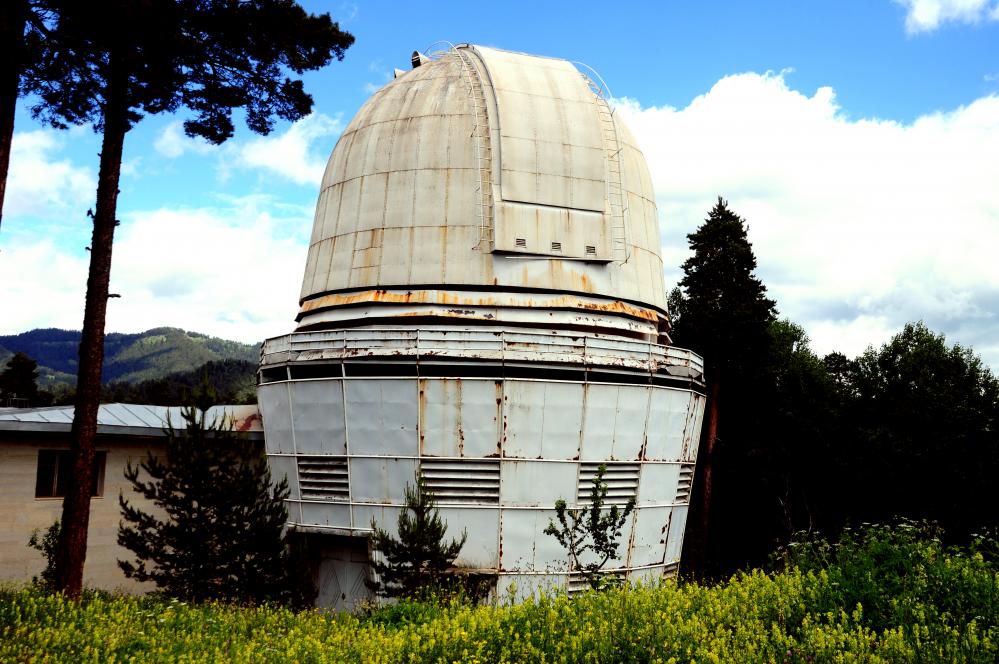
Fig. 5a. Dome of the 125-cm-Ritchey-Chrétien Reflector (Wikipedia 2, Sarah Murray))

Fig. 5b. 125-cm-Ritchey-Chrétien Reflector (1977) (© Abastumani Astrophysical Observatory)
Solar Physics Instruments
- Solar Telescopes
- 12-cm Lyot Solar Coronagraph
- 53-cm-Nikolsky type Large Solar Coronograph

Fig. 6. Abastumani Astrophysical Observatory (*1932), (credit: GENAO)
State of preservation
The original buildings and instruments are completely preserved.
The instruments are in good condition, but the buildings really need restoration.

Fig. 7. Abastumani Astrophysical Observatory (*1932), (credit: GENAO)
Comparison with related/similar sites
It can be compared with Lick Observatory, which was the earliest mountain observatory in the world (1888), and Abastumani Astrophysical Observatory was the first in the Soviet Union.
Threats or potential threats
no threats
Present use
The Observatory is still active in astrophysical research.
There is also research division for history of astronomy.
The Evgeny Kharadze Georgian National Astrophysical Observatory hosts weekly meet-seminars for students and young people interested in astronomy in order to promote astronomy education.
Astronomical relevance today
Main research topics are the following: the structure and evolution of galaxies, variable stars (photometric and spectrographic observations), solar physics, the Sun and the solar system bodies, investigations of the upper layers of Earth's atmosphere, and the history of astronomy. Since 2000 exists the Center for Plasma Astrophysics.
References
Bibliography (books and published articles)
-
Avrorin, É.N.; Balebanov, V.M.; Boyarchuk, A.A. et al.: Jumber Lominadze -- In Honor of his 70th Birthday. In: Plasma Physics Reports (2001, February), p. 178--179.
- Kharadze, Evgeny Kirillovich: Catalogue of the Color Indices of 14000 Stars and Investigation of Light Absorption in the Galaxy on the Basis of Color Indices of Stars. In: Bulletin of the Abastumani Astrophysical Observatory, No. 12 (1952), p. 375--419.
- Kharadze, Evgeny Kirillovich: Abastumani Astrophysical Observatory. Moscow: Publishing House of the USSR Academy of Sciences 1958.
- Kharadze, Evgeny Kirillovich: The Course of General Astrophysics.
- Kharadze, Evgeny Kirillovich: Principles of Astronomy, two volumes (in Georgian).
- Kharadze, Evgeny Kirillovic & N.L. Mahalashvili: P Cyg -- a W UMa Variable. In: Observatory 87 (1967), p. 295--296.
- Development of astronomy in the USSR. Moscow: Academy of Sciences 1967.
- Kiladze, Rolan Ilyich: Physical Parameters of Pluto. In: Solar System Research, Vol. 1 (1967), p. 173.
- Kiladze, Rolan Ilyich: Modern rotation of planets as a result of the development of circumplanetary swarms of small particles (1986).
- Kiladze, Rolan Ilyich: Modern Rotation of Planets, as a Result of Development of Small Particles (1986).
- Kiladze, Rolan Ilyich: Express Method of Detecting an Asteroid Colliding with Earth. In: Abastumanskaya Astrofiz. Obs. Byull., N 77 (2004), p. 13-26.
- Kiladze, Rolan Ilyich: Theory of Movement of Geostationary Satellites (2008).
- Kolchinsky, I.G.; Korsun, A.A. & M.G. Rodriguez: Astronomers: Biographical Guide. Kyiv: Naukova Dumka (2nd ed., revised. and additional) 1986 (512 p.).
- Mgaloblishvili, L.I.: Three presidents of the Georgian Academy of Sciences: Touches to the portraits of N.I. Muskheshvili, I.N. Vekua, E.K. Kharadze. Moscow: Academy of Sciences 2003 (in Georgian).
- Mekellor, Andrew, Victoria B.C.: The spectrum of comet Whipple-Fedtke-Tevzadze 1942. In: Astrophysical Journal, Vol. 99 (1944), N2.
- Salukvadze, G.N.: The Abastumani Astrophysical Observatory on Mount Kanobili. Tbilisi 1975.
- Schmadel, Lutz D.: Dictionary of Minor Planet Names. Fifth Revised and Enlarged Edition. Heidelberg, N.Y.: Springer 2003, p. 174.
Early Research on comets
- Martynov, D.Ya.: Comet 1942 Tevzadze-1. In: Astronomical Circular No. 11 (1943, February 12).
- Dubyago: Elements of the orbit of comet 1942 Tevzadze-1. In: Astronomical Circular No. 17 (July 1943).
- Barbashev: About comet 1942 Tevzadze-2. In: Bulletin of the Kharkov Observatory No. 4 (1944).
- Martynov D.Ya.: Comet 1942 Tevzadze-2. In: Astronomical Journal, vol. 21 (1944).
- Dubyago: Orbit of Comet 1942 Tevzadze-2. In: Astronomical Circular No. 21 (1943, August 26).
- Vorontsov-Velyaminov: Comet 1942 Tevzadze-2. In: Astronomical Journal, vol.e XX, issue 2 (1943).
Links to external sites
- Meniscus Telescope
- Abastumani Astrophysical Observatory
- Georgian National Astrophysical Observatory (Abastumani Astrophysical Observatory)
- Astrophysikalisches Observatorium Abastumani (Wikipedia)
- Evgeny Kirillovich Kharadze (1907--2001) (Wikipedia)
- Jumber Georgievich Lominadze (1931-- 2010) (Wikipedia)
- Rolan Ilyich Kiladze (1931-- 2010) (Wikipedia)
- Burton, Tara Isabella: Abastumani, hidden in the wild Georgian mountains, was a once-secret Soviet observatory. BBC Future visits to see how it has adapted to life after the Cold War (BBC, 5th November 2015)
- ...
Links to external on-line pictures
no information available
No multimedia content published
Currently there is no multimedia content published for this case study






